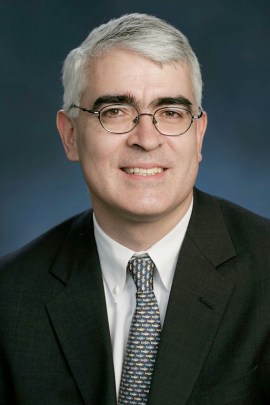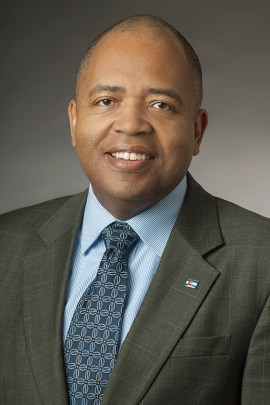The health insurance marketplaces created by the Affordable Care Act are in their fourth year of selling health insurance plans to people who don’t get insurance through work. Most states use Healthcare.gov to sell their plans, but 11 states and D.C. run their own marketplaces, also called exchanges. Under the vision of the law, the exchanges are supposed to become self-sustaining businesses within a few years, supported by the fees insurers pay to offer plans on the sites.
But with Donald Trump installed as president and Republican majorities controlling both houses of Congress that vision, like the rest of the health law, is in question.
Here, as the ACA’s fourth open enrollment draws to a close at the end of the month, five exchange leaders — who all report a brisk business despite the political peril — discuss their strategies to stay in business beyond 2017.
‘Make The Individual Market Work.’ – Peter Lee, Covered California Executive Director
More than five million Californians — about a quarter of all Americans now covered under Obamacare — gained insurance through the ACA, either through Medicaid expansion, or on the exchange, called Covered California. With the health law now on the political chopping block, California has a lot to lose.
But the executive director of Covered California, Peter Lee, said he’s planning on a different scenario—one that he hopes will position California as a leader in the push to find a new model for health care coverage nationwide.

Peter Lee (Courtesy of Covered California)
“I do think we have a number of the ingredients of [how to] make the individual market work,” said Lee. “And we want to take those lessons to members of Congress and to policy leaders.”
Lee said he plans to do that starting next week as a participant on a panel about the ACA repeal convened by two non-partisan research organizations in Washington, D.C.
In particular, Lee believes California’s market-based approach is one that would be “in sync, philosophically, with many of the things I hear from Republican and Democratic members of Congress and the Trump administration.”
“We have about 1.4 million Californians shopping in our marketplace picking private plans with the leg up of federal tax credits that make health care affordable to 90 percent of them,” Lee said.
California’s marketplace has had its share of problems. A reliance on inaccurate provider directories left some consumers exposed to higher-than-expected medical bills. Consumers also complained about narrow networks that left them unable choose the doctors they wanted.
But overall, the state is considered an ACA bellwether, thanks in part to innovative approaches, including state discretion to choose which insurers could operate in its market and then to negotiate premium prices and benefits with insurers.
“It’s a consumer-centric market solution,” Lee said. “Whether you’re a Republican or Democrat or Independent, it’s a market-based solution that has a lesson for the country.”
Still, Lee’s hopefulness is tempered by the knowledge that California faces a loss of $20 billion in federal funds if the promised Obamacare repeal happens without a replacement that preserves the Medicaid expansion and premium subsidies.
Under that scenario, Lee said, “People would have their health insurance pulled out from under them in droves.”
“The whole issue of repeal without replace is cataclysmic not just for California or Californians,” said Lee, “but for any of the 20 million Americans that have coverage because of the Affordable Care Act.”
Yet, Lee says, even in the face of a “very fuzzy” future, he’s focusing on the present, which includes shepherding more than 300,000 Californians newly enrolled in health care into 2017 coverage and on what parts of California’s plan can be adopted nationwide.
“There have been some things that have not worked great with the Affordable Care Act; there are things that have worked pretty darn well.” Lee said. “Let’s make sure the laboratory of the states is a laboratory [for] sharing the lessons of success and failure with one another.” ~Stephanie O’Neill

Donna Frescatore
Fearing A Return To ‘$1,000 A Month For An Individual Policy’ – Donna Frescatore, NY State of Health Executive Director
The New York state health exchange is fielding its busiest enrollment period yet, even in the uncertainty of the health law’s future.
A repeal of the ACA, without significant replacement, could cost 2.7 million New Yorkers their health insurance, and the state $3.7 billion, according to Gov. Andrew Cuomo’s office.
“We believe that the stakes here in New York are dramatic — for consumers, for our health care delivery system and for our state budget as well,” said Donna Frescatore, executive director of NY State of Health, New York’s marketplace.
Losing “momentum,” is one of Frescatore’s main concerns. Between 2013 and 2015, the uninsured rate in New York folded in half, from 10 to 5 percent, according to the state’s health department.
“We talk to moms who are concerned because their children have pre-existing conditions and they’re afraid coverage might no longer be available. We talk to self-employed New Yorkers who fear that the premiums could increase to the 2013 levels — over $1,000 a month for an individual policy,” Frescatore said.
Without financial support from the federal government, premiums may increase. Options may become reminiscent of health insurance plans as they were in pre-health-law New York.
“New York had a number of very strong consumer protections in place before the Affordable Care Act, including guaranteed issue. People could get insurance regardless of whether or not they had a medical condition or illness, as well as other consumer protections. We’ll maintain those protections,” said Frescatore.
But no insurance requirements or financial assistance, she adds, made plans “just out of reach.”
For now, the health exchange continues outreach to enroll consumers and reassures that, at least as far as they know, policies won’t be disrupted in 2017.
“At this point, without knowing more details about repeal or replacement, what we’re really focused on is getting people coverage that they deserve,” Frescatore said. ~Karen Shakerdge, WXXI and Side Effects Public Media

Jim Wadleigh
‘Do A Better Job Enforcing Special Enrollment’ – Jim Wadleigh, Access Health CT CEO
Connecticut was an early adopter of the ACA. After it passed, the state expanded Medicaid ahead of schedule to cover roughly 200,000 more people a year. This year, more than 100,000 people enrolled in coverage they found on the state-based exchange, with nearly 80 percent getting subsidies.
But while it may have been attractive to some consumers, it was less so to insurers. Two of the four original insurance companies in the marketplace are no longer in it. Now, with an uncertain future ahead, Access Health CT CEO Jim Wadleigh said he’s got one hard goal in mind as he thinks beyond 2017.
“What can we do to help make the business environment that our carriers are in easier for them to be more successful?”
Here’s one quick fix. Insurers have told Wadleigh that they lose money on customers who miss open enrollment periods and go through special enrollment — the process reserved for people with big life events or job changes that merits new insurance.
“What the carriers are telling us is, these customers are coming in… finding a reason that they have a life event because they’re sick, get services and then drop out.”
That’s an expensive pattern. This week, Wadleigh is asking his board to approve a plan to ramp up enforcement.
“If we can do a better job enforcing the special enrollment, we think we can reduce the premiums by potentially 6 to 10 percent.”
Another way to reduce costs? Shrink provider networks. So, let’s say you live in Hartford. Do you really need to pay for a plan that covers a doctor’s visit in Danbury?
“Customers are telling us they would go with a network choice option, or a narrow network, if it was cheaper and/or had a lower deductible.”
That, he said, could save another few percentage points in premium dollars.
Third, Wadleigh said he’s considering reforms that would push more of the cost of emergency room visits to consumers, hoping to deter frequent ER fliers.
The question is whether all of this will work. Wadleigh said he thinks it will. He’s already had discussions with existing carriers who are curious whether other insurers are looking to get into the marketplace.
“So what that is telling me is that the carriers think that we’re making changes in the positive direction, and expect that other carriers would be interested in joining our exchange with that.”
Whether they do — and whether the exchange will even be around for them to join — is still very much unclear. ~Jeff Cohen, WNPR

Louis Gutierrez
No Guarantees, But ‘Every Day Is a Good Day of Coverage.’ – Louis Gutierrez, Massachusetts Health Connector Executive Director
A near record number of Massachusetts residents are signing up for coverage through the state’s online insurance market, the Health Connector. Enrollment is up 32 percent over last year as the deadline of Jan. 31 approaches. Around 47,000 people who did not have insurance through the Connector last year have purchased insurance for 2017.
So many members, physicians and others in the health care world were stunned when Louis Gutierrez, who runs the Connector, said he could not guarantee coverage through the end of 2017 for the nearly 240,000 enrollees so far.
“I don’t want to be in the business of speculating or making commitments about things I can’t personally control,” Gutierrez said, adding “I don’t think any of us really know” what’s going to happen with the repeal of the ACA.
Gutierrez said he is not predicting precipitous changes but, “can’t speak to the future. Every day is a good day of coverage.”
Health insurers, who are threatening to pull out of exchanges in some states, are not the main concern in Massachusetts. Gutierrez said he’s hearing very little from the state’s “mature and stable market.” Most plans that sell insurance through the Connector are nonprofits based in the state. And they may have less reason to worry that healthy members will flee, leaving insurers to cover the high costs of ill members because Massachusetts residents would still be required to buy insurance by state law if the ACA mandate is repealed.
But if federal funds shrink or disappear, coverage would likely become very expensive for the 178,000 men and women who expect to receive subsidies or tax credits for insurance purchased through the Connector.
“We’re interested in maintaining broad and affordable access to coverage,” Gutierrez said, but “that will depend on the shape of any subsidies that change or happen in the new scheme.”
Many Massachusetts residents are wondering if the state could revert to “Romneycare,” the health reform law passed in 2006 when Mitt Romney was governor, which became a model for Obamacare. The individual mandate is still on the books, but the employer mandate and other elements were replaced with provisions in the federal law.
So what would it take to reconstruct Romneycare? Aides on Beacon Hill are going through state law to see which pieces are still in place and what would have to be restored. A number of provisions in the 2006 law, like the employer mandate, were removed because they were in conflict with Obamacare. It’s not clear right now what it would it take to make Romneycare workable again. ~Martha Bebinger, WBUR

Kevin Patterson
Lessons For ‘Whatever Post-ACA Is’ – Kevin Patterson, Chief Executive Officer Connect for Health Colorado
The view from Kevin Patterson, the CEO of Connect for Health Colorado, might be summarized as sunny with storm clouds on the horizon.
Patterson said enrollment numbers for 2017 are running 15 percent ahead of last year. “I think we’re feeling like things are going really well,” he said
But two things are clouding its future – first, the new Trump administration and Congressional Republicans vowing to undo Obamacare.
And in Colorado, the exchange is facing headwinds closer to home from state legislators. The legislative session got underway this month and as one of the first orders of business, Republicans unveiled a bill to repeal the exchange altogether. They are expected to zero in on a recent federal audit that found the exchange improperly spent millions in federal funds and called for that money to be returned. Patterson said the exchange has made many changes and disagrees with the recommendation to refund the money.
But if the exchange survives legislative turmoil, it still faces the possibility of federal subsidies disappearing. But Patterson believes the exchange could carry on. “I don’t know what our footprint might be,” he concedes. But he thinks it has a role in helping consumers with the eligibility process. “I do think there are things that we’ve learned that could be applied in a new era or whatever post-ACA is,” he said.
But he worries an Obamacare repeal without a timely, adequate replacement could cause some insurers to pull out of the exchange or charge higher rates. Already consumers saw premiums go up and choice go down this year. And this is pressing — insures have to file rate requests in Colorado in May. “So the clock is ticking,” Patterson said. “Somebody has to give us a little more guidance I think to the industry around what the new world is going to look like. And I think the sooner we do that the better it is for every consumer.”
But, he said beyond 2017, the exchange could look to expand its other lines of business beyond the individual marketplace, including helping large and small employers figure our insurance packages and benefits. “I think that’s somewhere where we can show some more value,” he said.
Colorado’s exchange is also flirting with the possibility of working with neighboring states, particularly those in the mountain time zone. “We’re kind of used to working together as western states on problems that are really unique to us,” Patterson said. “That’s where I would start.” ~John Daley, Colorado Public Radio
This story is part of a reporting partnership with NPR, local member stations and Kaiser Health News.
Correction: A previous version of this story stated that the insurance marketplaces created by the Affordable Care Act were in their third year of open enrollment. The marketplaces were in their fourth year. KHN regrets the error.







